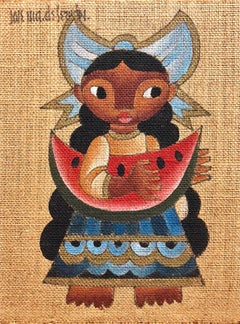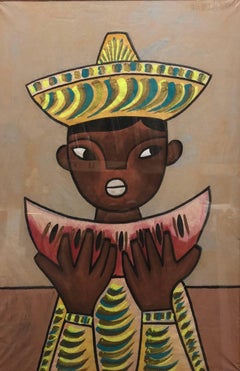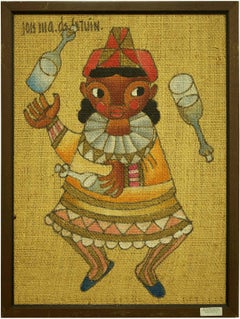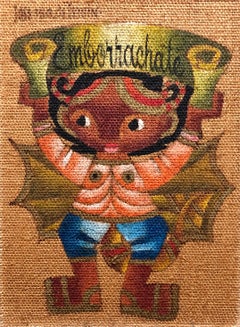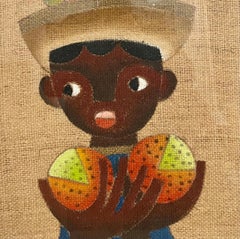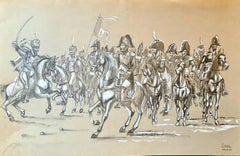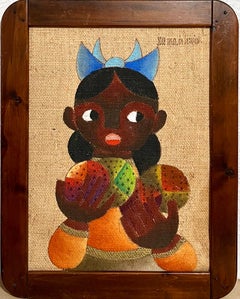Jose Maria de Servin Figurative Paintings
to
2
3
2
Overall Width
to
Overall Height
to
7
7
1
1
1
1
1
7
6
6
6
1
9
465
321
258
228
7
Artist: Jose Maria de Servin
Folk Art Mexican Girl with Watermelon Oil Painting on Burlap
By Jose Maria de Servin
Located in Surfside, FL
The sweetness that characterizes the work of Mexican painter Jose Maria de Servin (1917-83) is a melancholy and placid one. While he worked in the most modern of styles, he adapted i...
Category
Mid-20th Century Folk Art Jose Maria de Servin Figurative Paintings
Materials
Burlap, Oil
Mexican Modernist Painting Boy with Watermelon
By Jose Maria de Servin
Located in Surfside, FL
Genre: Latin American
Subject: Children
Medium: Mixed Media
Surface: Paper
Country: Mexico
Dimensions include Frame: 36X26
The sweetness that characterizes the work of Mexican pai...
Category
20th Century Folk Art Jose Maria de Servin Figurative Paintings
Materials
Paper, Gouache
Folk Art Mexican Girl, Circus Clown Juggler
By Jose Maria de Servin
Located in Surfside, FL
The sweetness that characterizes the work of Mexican painter Jose Maria de Servin (1917-83) is a melancholy and placid one. While he worked in the most modern of styles, he adapted i...
Category
Mid-20th Century Folk Art Jose Maria de Servin Figurative Paintings
Materials
Burlap, Oil
Folk Art Mexican Girl "Emborrachate" Oil Painting on Burlap
By Jose Maria de Servin
Located in Surfside, FL
The sweetness that characterizes the work of Mexican painter Jose Maria de Servin (1917-83) is a melancholy and placid one. While he worked in the most modern of styles, he adapted i...
Category
Mid-20th Century Folk Art Jose Maria de Servin Figurative Paintings
Materials
Burlap, Oil
Folk Art Mexican Boy Oil Painting on Burlap Charming Naive African American Art
By Jose Maria de Servin
Located in Surfside, FL
Framed 29 X 23
Image 18 X 24
The sweetness that characterizes the work of Mexican painter Jose Maria de Servin (1917-83) is a melancholy and placid one. While he worked in the mo...
Category
Mid-20th Century Folk Art Jose Maria de Servin Figurative Paintings
Materials
Burlap, Oil
Mexican Boy with Bird
By Jose Maria de Servin
Located in Surfside, FL
The sweetness that characterizes the work of Mexican painter Jose Maria de Servin (1917-83) is a melancholy and placid one. While he worked in the most modern of styles, he adapted i...
Category
20th Century Jose Maria de Servin Figurative Paintings
Materials
Burlap, Oil
Folk Art Mexican Girl Oil Painting on Burlap Charming Naive African American Art
By Jose Maria de Servin
Located in Surfside, FL
Framed 29 X 23
Image 18 X 24
The sweetness that characterizes the work of Mexican painter Jose Maria de Servin (1917-83) is a melancholy and placid one. While he worked in the mo...
Category
Mid-20th Century Folk Art Jose Maria de Servin Figurative Paintings
Materials
Burlap, Oil
Related Items
Napoleon at the Head of His Grande Armée, His Generals and the Prussian Hussars
Located in Cotignac, FR
Pencil, chalk and watercolour depiction of Napoleon at the head of his generals by French artist Jean Ducel. The work is signed bottom right.
A bold and graphic depiction of Napoleo...
Category
Late 20th Century Outsider Art Jose Maria de Servin Figurative Paintings
Materials
Chalk, Crayon, Cardboard, Pencil, Watercolor
Father Christmas
Located in Wilton Manors, FL
Beautiful original Folk Art painting by American artist, Arthur Glazier (1928-2015).
Oil on canvas, measuring 14 x 18 inches.
Signed lower bottom.
Arthur was born May 29, 1928, ...
Category
1970s Folk Art Jose Maria de Servin Figurative Paintings
Materials
Canvas, Oil
1910's Art Deco Erte Gouache Painting Original Hand Signed Rare French Costume
By Erté
Located in Buffalo, NY
A rare original signed Art Deco gouache on paper by Erte (Romain de Tirtoff)
.
This stunning theatrical costume design is signed Erte at the lower right.
The piece is 20 by 18 fram...
Category
1910s Art Deco Jose Maria de Servin Figurative Paintings
Materials
Gouache, Archival Paper, Pencil
$6,400 Sale Price
20% Off
H 20 in W 18 in
Balance, Whimsical female with flowers, roses, bright golden sky
By Stephen Basso
Located in Brooklyn, NY
*ABOUT Stephen Basso
Stephen Basso's highly original pastels and oil paintings are romantic, yet thought provoking fantasies. His whimsical works are alive with boundless imagina...
Category
2010s Outsider Art Jose Maria de Servin Figurative Paintings
Materials
Canvas, Oil
$3,200
H 40 in W 40 in D 2 in
"Mujer de Cajamarca, " Oil Painting on Jute signed by Ernesto Gutierrez
By Ernesto Gutierrez (b.1941)
Located in Milwaukee, WI
"Mujer de Cajamarca" is an original oil painting on jute by Ernesto Gutierrez. The artist signed the piece in the lower right. It depicts a woman seated in front of an archway.
16"...
Category
Early 2000s Contemporary Jose Maria de Servin Figurative Paintings
Materials
Jute, Oil
Boulevard of flowers Barcelona Spain oil on burlap painting spanish urbanscape
By Jordi Curos
Located in Sitges, Barcelona
Jordi Curós Ventura (1930-2007) - Barcelona - Oil on burlap
Oil measures 73x60 cm.
Frameless..
Jordi Curós Ventura (Olot, Girona, March 4, 1930) is a Cata...
Category
1990s Post-Impressionist Jose Maria de Servin Figurative Paintings
Materials
Oil, Burlap
$645 Sale Price
38% Off
H 28.75 in W 23.63 in
Mid Century Watercolour of the Wild West, Here Come The Cavalry
Located in Cotignac, FR
Mid Century pencil, chalk, watercolour and gouache painting of an American cavalry officer riding his horse across the dessert.
This artwork captures the dynamic energy of a lone c...
Category
Mid-20th Century Outsider Art Jose Maria de Servin Figurative Paintings
Materials
Chalk, Crayon, Watercolor, Cardboard, Pencil
"Once Upon a Time" Mid Century Figurative Landscape
Located in Soquel, CA
Charming mid-century naive painting of small figures and chickens in a rural landscape by an unknown artist (American, 20th Century). Signed with the monogram "I. M. H." on lower lef...
Category
1960s Folk Art Jose Maria de Servin Figurative Paintings
Materials
Canvas, Oil, Cardboard
$372 Sale Price
20% Off
H 14 in W 18 in D 2 in
Early 20th-Century English School, John Lovibond & Sons, Cannon Brewery, Fulham
Located in Cheltenham, GB
This charming early 20th-century English School oil painting depicts the Cannon Brewery at North End, Fulham, owned by John Lovibond & Sons Ltd.
Founded in 1867, the brewery was...
Category
Early 1900s Folk Art Jose Maria de Servin Figurative Paintings
Materials
Canvas, Oil
Abstract Expressionist CoBRA Style Fantastical Figure. Acrylic on Card.
Located in Cotignac, FR
Abstract expressionist CoBrA style acrylic on card of a humanised figure attributed to French artist, A Nuchy. The work is signed bottom right and stamped with the Atelier stamp to t...
Category
Late 20th Century Outsider Art Jose Maria de Servin Figurative Paintings
Materials
Acrylic, Cardboard, Watercolor
$394 Sale Price
26% Off
H 21.07 in W 15.56 in D 0.08 in
1950s "Curled Up Cubist" MidCentury Figurative Gouache University of Paris
By Donald Stacy
Located in Arp, TX
Donald Stacy
"Curled Up Cubist
c.1950s
Gouache on paper
24" x 18" unframed
Unsigned
Came from artist's estate
Donald Stacy (1925-2011) New Jersey
Studied: Newark School of Fine Art
The Art Students League
Pratt Graphic Arts Center
University of Paris 1953-54
University of Aix-en-Provence 1954-55
Faculty: Art Department of the New School
Museum of Modern Art
School of Visual Arts
Stacy Studio Workshop
Exhibitions: Grand Central Moderns
George Wittenborn
The New School
Print Exhibitions, Chicago
University of Oklahoma
Honolulu Museum
Monclair Museum
Wisconsin State College
Louisiana Art Commission
Philadelphia...
Category
Mid-20th Century American Modern Jose Maria de Servin Figurative Paintings
Materials
Paper, Gouache
Lover Boy, colorful humorous woman and Cat
By Stephen Basso
Located in Brooklyn, NY
oil on linen on mounted board
*ABOUT Stephen Basso
Stephen Basso's highly original pastels and oil paintings are romantic, yet thought provoking fanta...
Category
2010s Outsider Art Jose Maria de Servin Figurative Paintings
Materials
Linen, Oil
Previously Available Items
Folk Art Mexican Boy Oil Painting on Burlap Charming Naive African American Art
By Jose Maria de Servin
Located in Surfside, FL
Framed 29 X 23
Image 18 X 24
The sweetness that characterizes the work of Mexican painter Jose Maria de Servin (1917-83) is a melancholy and placid one. While he worked in the most modern of styles, he adapted it to an anecdotal folk-art approach distinctly his own.
When he was an infant, de Servin's family moved with him to Guadalajara. A city of history and culture, Guadalajara had a thriving artistic community with strong connections to Europe. His brothers Antonio and Miguel became artists as well, and in later years they worked collaboratively. As a teenager, de Servin studied at one of Mexico's Schools of Open-Air Painting, free art-teaching institutions sponsored by the government.
Later de Servin became a pupil of the painter Chucho Reyes, known for his improvisational watercolor variations on traditional Mexican themes. This interest in imagery particular to Mexico would be of great significance to de Servin. De Servin also studied under the more traditional painter Jose Vizcarra. In the early 1930s de Servin joined the Pintores Jovenes de Jalisco, or Young Painters of Jalisco.
An influence of critical importance to de Servin was Pablo Picasso. One of the originators of Cubism, the Spanish painter soon departed from its quasi-scientific and optical basis to create lively and humorous geometrical abstractions. It was this Cubism, personal and decorative, that de Servin adopted. His earliest Cubist works mimic Picasso, while during the second stage of his career, his works become smooth and polished, with an emphasis on gentle surface textures.
After these cautious years, however, a rough boldness enters along with dominating colors of earth and sand. Modernists like de Servin were interested in exploring what they considered primitive artmaking styles. The adoption of a native manner and native themes is in keeping with Modernist tenets, as is the use of nontraditional materials. De Servin's portraits of peasants, large-eyed and simply rendered, recall children's drawings. The rough burlap ground contrasts with the playful imagery and delicate range of color. The figures, all children or child-like adults, are all curves and simple shapes arranged harmoniously. De Servin's cubism is free from grotesquerie as it celebrates the simplicity of its subjects.
De Servin worked with the social-realist Jose Orozco on several large mural commissions in Guadalajara, including one at the Legislative Palace. While their styles were dissimilar, both made use of Mexican imagery to glorify the common people. A sought-after muralist in his own right, de Servin brought the rich colors and endearing characters of his panels to his larger-scale work.
For 15 years, de Servin taught summer art classes at the University of Arizona. His career was marked by many one-man shows, both in North America and Europe. In recent years, his striking style has attracted increased notice from critics and the public.
His style is a unique conglomerate of tradition, history, legends, heroes, old customs and folklore. It is a self-standing style, recognizable, cheerful, whimsical and a happy creation. Naïve art is any form of visual art that is created by a person who lacks the formal education and training that a professional artist undergoes (in anatomy, art history, technique, perspective, ways of seeing). Unlike folk art, naïve art does not necessarily evince a distinct cultural context or tradition. Naïve art is recognized, and often imitated, for its childlike simplicity and frankness. Paintings of this kind typically have a flat rendering style with a rudimentary expression of perspective.
One particularly influential painter of "naïve art" was Henri Rousseau (1844–1910), a French Post-Impressionist who was discovered by Pablo Picasso. Naïve art is often seen as outsider art that is by someone without formal (or little) training or degree. While this was true before the twentieth century, there are now academies for naïve art. Naïve art is now a fully recognized art genre, represented in art galleries worldwide.
Museums devoted to naïve art now exist in Kecskemét, Hungary; Riga, Latvia; Jaen, Spain; Rio de Janeiro, Brasil; Vicq France and Paris. "Primitive art" is another term often applied to art by those without formal training, but is historically more often applied to work from certain cultures that have been judged socially or technologically "primitive" by Western academia, such as Native American, sub saharan African or Pacific Island art (see Tribal art). This is distinguished from the self-conscious, "primitive" inspired movement primitivism. Another term related to (but not completely synonymous with) naïve art is folk art. There also exist the terms "naïvism" and "primitivism" which are usually applied to professional painters working in the style of naïve art (like Paul Gauguin, Mikhail Larionov, Paul Klee).
At all events, naive art can be regarded as having occupied an "official" position in the annals of twentieth-century art since - at the very latest - the publication of the Der Blaue Reiter, an almanac in 1912. Wassily Kandinsky and Franz Marc, who brought out the almanac, presented 6 reproductions of paintings by le Douanier' Rousseau (Henri Rousseau), comparing them with other pictorial examples. However, most experts agree that the year that naive art was "discovered" was 1885, when the painter Paul Signac became aware of the talents of Henri Rousseau and set about organizing exhibitions of his work in a number of prestigious galleries. The Earth Group (Grupa Zemlja) were Croatian artists, architects and intellectuals active in Zagreb from 1929 to 1935. The group included the painters Krsto Hegedušić, Edo Kovačević, Omer Mujadžić, Kamilo Ružička, Ivan Tabaković, and Oton Postružnik, the sculptors Antun Augustinčić, Frano Kršinić, and the architect Drago Ibler. A term applied to Yugoslav (Croatian) naive painters working in or around the village of Hlebine, near the Hungarian border, from about 1930. Some of the best known naive artists are Dragan Gaži, Ivan Generalić, Josip Generalić, Krsto Hegedušić, Mijo Kovačić, Ivan Lacković-Croata, Franjo Mraz, Ivan Večenaj and Mirko Virius. Camille Bombois (1883–1970) Ferdinand Cheval, known as 'le facteur Cheval' (1836–1924) Henry Darger (1892–1973) L. S. Lowry (1887–1976) Grandma Moses, Anna Mary Robertson (1860–1961) Nikifor (1895–1968) Poland, Horace Pippin (1888–1946) Jon Serl (1894-1993) United States Alfred Wallis (1855–1942) Scottie Wilson (1890–1972) Gesner Abelard...
Category
Mid-20th Century Folk Art Jose Maria de Servin Figurative Paintings
Materials
Burlap, Oil
Folk Art Mexican Girl Oil Painting on Burlap Charming Naive African American Art
By Jose Maria de Servin
Located in Surfside, FL
Framed 29 X 23
Image 18 X 24
The sweetness that characterizes the work of Mexican painter Jose Maria de Servin (1917-83) is a melancholy and placid one. While he worked in the most modern of styles, he adapted it to an anecdotal folk-art approach distinctly his own.
When he was an infant, de Servin's family moved with him to Guadalajara. A city of history and culture, Guadalajara had a thriving artistic community with strong connections to Europe. His brothers Antonio and Miguel became artists as well, and in later years they worked collaboratively. As a teenager, de Servin studied at one of Mexico's Schools of Open-Air Painting, free art-teaching institutions sponsored by the government.
Later de Servin became a pupil of the painter Chucho Reyes, known for his improvisational watercolor variations on traditional Mexican themes. This interest in imagery particular to Mexico would be of great significance to de Servin. De Servin also studied under the more traditional painter Jose Vizcarra. In the early 1930s de Servin joined the Pintores Jovenes de Jalisco, or Young Painters of Jalisco.
An influence of critical importance to de Servin was Pablo Picasso. One of the originators of Cubism, the Spanish painter soon departed from its quasi-scientific and optical basis to create lively and humorous geometrical abstractions. It was this Cubism, personal and decorative, that de Servin adopted. His earliest Cubist works mimic Picasso, while during the second stage of his career, his works become smooth and polished, with an emphasis on gentle surface textures.
After these cautious years, however, a rough boldness enters along with dominating colors of earth and sand. Modernists like de Servin were interested in exploring what they considered primitive artmaking styles. The adoption of a native manner and native themes is in keeping with Modernist tenets, as is the use of nontraditional materials. De Servin's portraits of peasants, large-eyed and simply rendered, recall children's drawings. The rough burlap ground contrasts with the playful imagery and delicate range of color. The figures, all children or child-like adults, are all curves and simple shapes arranged harmoniously. De Servin's cubism is free from grotesquerie as it celebrates the simplicity of its subjects.
De Servin worked with the social-realist Jose Orozco on several large mural commissions in Guadalajara, including one at the Legislative Palace. While their styles were dissimilar, both made use of Mexican imagery to glorify the common people. A sought-after muralist in his own right, de Servin brought the rich colors and endearing characters of his panels to his larger-scale work.
For 15 years, de Servin taught summer art classes at the University of Arizona. His career was marked by many one-man shows, both in North America and Europe. In recent years, his striking style has attracted increased notice from critics and the public.
His style is a unique conglomerate of tradition, history, legends, heroes, old customs and folklore. It is a self-standing style, recognizable, cheerful, whimsical and a happy creation. Naïve art is any form of visual art that is created by a person who lacks the formal education and training that a professional artist undergoes (in anatomy, art history, technique, perspective, ways of seeing). Unlike folk art, naïve art does not necessarily evince a distinct cultural context or tradition. Naïve art is recognized, and often imitated, for its childlike simplicity and frankness. Paintings of this kind typically have a flat rendering style with a rudimentary expression of perspective.
One particularly influential painter of "naïve art" was Henri Rousseau (1844–1910), a French Post-Impressionist who was discovered by Pablo Picasso. Naïve art is often seen as outsider art that is by someone without formal (or little) training or degree. While this was true before the twentieth century, there are now academies for naïve art. Naïve art is now a fully recognized art genre, represented in art galleries worldwide.
Museums devoted to naïve art now exist in Kecskemét, Hungary; Riga, Latvia; Jaen, Spain; Rio de Janeiro, Brasil; Vicq France and Paris. "Primitive art" is another term often applied to art by those without formal training, but is historically more often applied to work from certain cultures that have been judged socially or technologically "primitive" by Western academia, such as Native American, sub saharan African or Pacific Island art (see Tribal art). This is distinguished from the self-conscious, "primitive" inspired movement primitivism. Another term related to (but not completely synonymous with) naïve art is folk art. There also exist the terms "naïvism" and "primitivism" which are usually applied to professional painters working in the style of naïve art (like Paul Gauguin, Mikhail Larionov, Paul Klee).
At all events, naive art can be regarded as having occupied an "official" position in the annals of twentieth-century art since - at the very latest - the publication of the Der Blaue Reiter, an almanac in 1912. Wassily Kandinsky and Franz Marc, who brought out the almanac, presented 6 reproductions of paintings by le Douanier' Rousseau (Henri Rousseau), comparing them with other pictorial examples. However, most experts agree that the year that naive art was "discovered" was 1885, when the painter Paul Signac became aware of the talents of Henri Rousseau and set about organizing exhibitions of his work in a number of prestigious galleries. The Earth Group (Grupa Zemlja) were Croatian artists, architects and intellectuals active in Zagreb from 1929 to 1935. The group included the painters Krsto Hegedušić, Edo Kovačević, Omer Mujadžić, Kamilo Ružička, Ivan Tabaković, and Oton Postružnik, the sculptors Antun Augustinčić, Frano Kršinić, and the architect Drago Ibler. A term applied to Yugoslav (Croatian) naive painters working in or around the village of Hlebine, near the Hungarian border, from about 1930. Some of the best known naive artists are Dragan Gaži, Ivan Generalić, Josip Generalić, Krsto Hegedušić, Mijo Kovačić, Ivan Lacković-Croata, Franjo Mraz, Ivan Večenaj and Mirko Virius. Camille Bombois (1883–1970) Ferdinand Cheval, known as 'le facteur Cheval' (1836–1924) Henry Darger (1892–1973) L. S. Lowry (1887–1976) Grandma Moses, Anna Mary Robertson (1860–1961) Nikifor (1895–1968) Poland, Horace Pippin (1888–1946) Jon Serl (1894-1993) United States Alfred Wallis (1855–1942) Scottie Wilson (1890–1972) Gesner Abelard...
Category
Mid-20th Century Folk Art Jose Maria de Servin Figurative Paintings
Materials
Burlap, Oil
Mexican Modernist Painting Girl with Watermelon
By Jose Maria de Servin
Located in Surfside, FL
Genre: Latin American
Subject: Children
Medium: Mixed Media
Surface: Paper
Country: Mexico
Dimensions include Frame: 36X26
The sweetness that characterizes the work of Mexican pai...
Category
20th Century Folk Art Jose Maria de Servin Figurative Paintings
Materials
Paper, Gouache
Mexican Boy with Bird
By Jose Maria de Servin
Located in Surfside, FL
The sweetness that characterizes the work of Mexican painter Jose Maria de Servin (1917-83) is a melancholy and placid one. While he worked in the most modern of styles, he adapted i...
Category
20th Century Jose Maria de Servin Figurative Paintings
Materials
Burlap, Oil
Folk Art Mexican Girl "Emborrachate" Oil Painting on Burlap
By Jose Maria de Servin
Located in Surfside, FL
The sweetness that characterizes the work of Mexican painter Jose Maria de Servin (1917-83) is a melancholy and placid one. While he worked in the most modern of styles, he adapted i...
Category
Mid-20th Century Folk Art Jose Maria de Servin Figurative Paintings
Materials
Burlap, Oil
Folk Art Mexican Girl with Watermelon Oil Painting on Burlap
By Jose Maria de Servin
Located in Surfside, FL
The sweetness that characterizes the work of Mexican painter Jose Maria de Servin (1917-83) is a melancholy and placid one. While he worked in the most modern of styles, he adapted i...
Category
Mid-20th Century Folk Art Jose Maria de Servin Figurative Paintings
Materials
Burlap, Oil
Mexican Modernist Painting Girl with Watermelon
By Jose Maria de Servin
Located in Surfside, FL
Genre: Latin American
Subject: Children
Medium: Mixed Media
Surface: Paper
Country: Mexico
Dimensions include Frame: 36X26
The sweetness that characterizes the work of Mexican pai...
Category
20th Century Folk Art Jose Maria de Servin Figurative Paintings
Materials
Paper, Gouache
Mexican Modernist Painting Boy with Watermelon
By Jose Maria de Servin
Located in Surfside, FL
Genre: Latin American
Subject: Children
Medium: Mixed Media
Surface: Paper
Country: Mexico
Dimensions include Frame: 36X26
The sweetness that characterizes the work of Mexican pai...
Category
20th Century Folk Art Jose Maria de Servin Figurative Paintings
Materials
Paper, Gouache
Mexican Modernist 'Palomitas'
By Jose Maria de Servin
Located in Surfside, FL
Here, the artist Jose Maria de Servin uses tempera and encaustic on board to render the subject, in this case a Virgin holding child surrounded by doves against a black background. T...
Category
20th Century Folk Art Jose Maria de Servin Figurative Paintings
Materials
Mixed Media, Board
Folk Art Mexican Girl, Circus Clown Juggler
By Jose Maria de Servin
Located in Surfside, FL
The sweetness that characterizes the work of Mexican painter Jose Maria de Servin (1917-83) is a melancholy and placid one. While he worked in the most modern of styles, he adapted i...
Category
Mid-20th Century Folk Art Jose Maria de Servin Figurative Paintings
Materials
Burlap, Oil
Mexican Boy with Bird
By Jose Maria de Servin
Located in Surfside, FL
The sweetness that characterizes the work of Mexican painter Jose Maria de Servin (1917-83) is a melancholy and placid one. While he worked in the most modern of styles, he adapted i...
Category
20th Century Jose Maria de Servin Figurative Paintings
Materials
Burlap, Oil
Jose Maria De Servin figurative paintings for sale on 1stDibs.
Find a wide variety of authentic Jose Maria de Servin figurative paintings available for sale on 1stDibs. You can also browse by medium to find art by Jose Maria de Servin in paint, burlap, fabric and more. Not every interior allows for large Jose Maria de Servin figurative paintings, so small editions measuring 18 inches across are available. Customers who are interested in this artist might also find the work of Madeline Christine Clavier, Rachel Srinivasan, and Johnny Banks. Jose Maria de Servin figurative paintings prices can differ depending upon medium, time period and other attributes. On 1stDibs, the price for these items starts at $1,600 and tops out at $2,500, while the average work can sell for $2,000.
